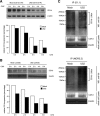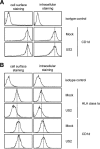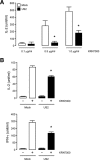Human cytomegalovirus (HCMV) US2 protein interacts with human CD1d (hCD1d) and down-regulates invariant NKT (iNKT) cell activity
- PMID: 24213674
- PMCID: PMC3887943
- DOI: 10.1007/s10059-013-0221-8
Human cytomegalovirus (HCMV) US2 protein interacts with human CD1d (hCD1d) and down-regulates invariant NKT (iNKT) cell activity
Abstract
To avoid host immune surveillance, human cytomegalovirus (HCMV) encoded endoplasmic reticulum (ER)-membrane glycoprotein US2, which interferes with antigen presenting mechanism of Major histocompatibility complex (MHC) class Ia and class II molecules. However, not many attempts have been made to study the effect of HCMV US2 on the expression of MHC class Ib molecules. In this study, we examined the effect of HCMV US2 on the expression and function of human CD1d (hCD1d), which presents glycolipid antigens to invariant NKT (iNKT) cells. Our results clearly showed that the physiological interaction between ER lumenal domain of HCMV US2 and α3 domain of hCD1d was observed within ER. Compared with mature form of hCD1d, immature form of hCD1d is more susceptible to ubiquitin-dependent proteasomal degradation mediated by HCMV US2. Moreover, the ectopic expression of HCMV US2 leads to the down-modulation of iNKT cell activity without significant change of hCD1d expression. These results will advance our understanding of the function of HCMV US2 in immune evasive mechanisms against anti-viral immunity of iNKT cells.
Figures





Similar articles
-
Human CD1d molecules are resistant to human cytomegalovirus US2- and US11-mediated degradation.Biochem Biophys Res Commun. 2011 Oct 7;413(4):616-22. doi: 10.1016/j.bbrc.2011.09.013. Epub 2011 Sep 6. Biochem Biophys Res Commun. 2011. PMID: 21925141
-
Subtle sequence variation among MHC class I locus products greatly influences sensitivity to HCMV US2- and US11-mediated degradation.Int Immunol. 2006 Jan;18(1):173-82. doi: 10.1093/intimm/dxh362. Epub 2005 Dec 16. Int Immunol. 2006. PMID: 16361314
-
Binding of human cytomegalovirus US2 to major histocompatibility complex class I and II proteins is not sufficient for their degradation.J Virol. 2002 Aug;76(16):8265-75. doi: 10.1128/jvi.76.16.8265-8275.2002. J Virol. 2002. PMID: 12134032 Free PMC article.
-
Identifying the ERAD ubiquitin E3 ligases for viral and cellular targeting of MHC class I.Mol Immunol. 2015 Dec;68(2 Pt A):106-11. doi: 10.1016/j.molimm.2015.07.005. Epub 2015 Jul 22. Mol Immunol. 2015. PMID: 26210183 Free PMC article. Review.
-
Inhibition of the MHC class II antigen presentation pathway by human cytomegalovirus.Curr Top Microbiol Immunol. 2002;269:101-15. doi: 10.1007/978-3-642-59421-2_7. Curr Top Microbiol Immunol. 2002. PMID: 12224504 Review.
Cited by
-
The surveillance of viral infections by the unconventional Type I NKT cell.Front Immunol. 2024 Sep 17;15:1472854. doi: 10.3389/fimmu.2024.1472854. eCollection 2024. Front Immunol. 2024. PMID: 39355244 Free PMC article. Review.
-
Mutational analysis of pig tissue factor pathway inhibitor α to increase anti-coagulation activity in pig-to-human xenotransplantation.Biotechnol Lett. 2024 Aug;46(4):521-530. doi: 10.1007/s10529-024-03505-z. Epub 2024 Jun 13. Biotechnol Lett. 2024. PMID: 38872071
-
Virological, innate, and adaptive immune profiles shaped by variation in route and age of host in murine cytomegalovirus infection.J Virol. 2024 May 14;98(5):e0198623. doi: 10.1128/jvi.01986-23. Epub 2024 Apr 15. J Virol. 2024. PMID: 38619272 Free PMC article.
-
Varicella Zoster Virus Downregulates Expression of the Nonclassical Antigen Presentation Molecule CD1d.J Infect Dis. 2024 Aug 16;230(2):e416-e426. doi: 10.1093/infdis/jiad512. J Infect Dis. 2024. PMID: 37972257 Free PMC article.
-
Insights into the Transcriptome of Human Cytomegalovirus: A Comprehensive Review.Viruses. 2023 Aug 8;15(8):1703. doi: 10.3390/v15081703. Viruses. 2023. PMID: 37632045 Free PMC article. Review.
References
-
- Balk SP, Burke S, Polischuk JE, Frantz ME, Yang L, Porcelli S, Colgan SP, Blumberg RS. β2-microglo-bulin-independent MHC class Ib molecule expressed by human intestinal epithelium. Science. 1994;265:259–262. - PubMed
-
- Bendelac A, Savage PB, Teyton L. The biology of NKT cells. Annu Rev Immunol. 2007;25:297–336. - PubMed
-
- Cho S, Jun Y. Human CD1d molecules are resistant to human cytomegalovirus US2- and US11-mediated degradation. Biochem Biophys Res Commun. 2011;413:616–622. - PubMed
Publication types
MeSH terms
Substances
LinkOut - more resources
Full Text Sources
Other Literature Sources
Research Materials

